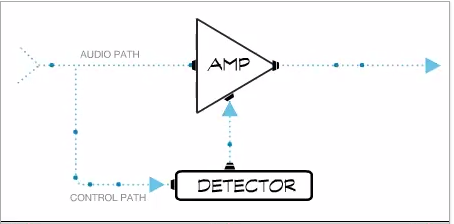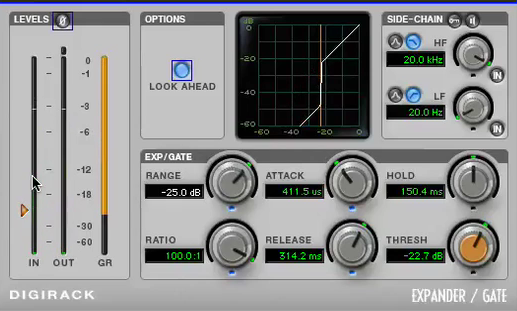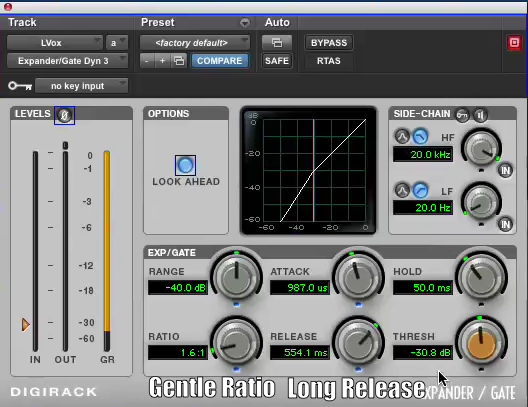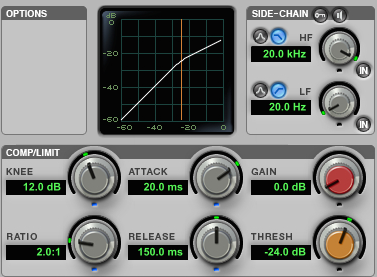hamstank
New member
Hi FP! This is another set of notes I have on Dynamics Processors. These are gates, downward expanders, compressors, etc. These are the basics; my next thread will be about detailing cool techniques where you can use EQ and Compression strategically! Also, check out my thread on EQ. Let me know if you have any questions!
Intro to Dynamics Processors: Gates and Expanders

Gates

 Filtering the Key Signal
Filtering the Key Signal
Gates vs. Downward Expanders

Compressors and Limiters




Attack = 20 ms; at 20 ms, the attack time is fast enough that it will clamp down on transients but not so fast that it's going to immediately harm the articulation and intelligibility of your signals. From here, if you want a more aggressive compression, you could go with a faster attack time, where's you want to let more of the attack transients come through.
Ratio = 2:1; with a ratio of 2 to 1, you will get the gain reduction but at the same time not compromise audio signals. From here, if you want to go with more aggressive compression that really reduces the dynamic range above the threshold, you might start thinking about 4:1, even 6:1.
Release = 150 ms; this setting would be the most variable, as it's going to depend on the kind of signal you are working with and other issues such as the tempo of the song. Start around 150 ms, maybe 200, and listen carefully to the compressor. If you want a louder sound with a little more energy to it, start exploring shorter release times from here, where if you would like a smoother and more consistent sound you might explore longer release times.
Threshold =?; As a starting point, aim for a Threshold setting that gets you around -6 dB of gain reduction with these settings.
Gain = Bypass!; This is the most important parameter to think about on a compressor. When setting the compressor, it's really important that you keep tweaking the Gain parameter so that the loudness of the compressed signal is the same as the loudness when you bypass the compressor. This approach will ensure that you don't hear a difference in level between your compressed and uncompressed signal.
Limiters
Intro to Dynamics Processors: Gates and Expanders
- Dynamics Processors include:
- gates
- expanders (downward and upward)
- compressors
- limiters
- duckers
- de-essers
- gates
- In a dynamics processor, you set an amplitude threshold, and the dynamics processor responds to the signal based on the signal's relationship to the threshold.
- Compressors, limiters, de-essers, and duckers act upon the signal when it exceeds the threshold
- Gates and downward expanders act upon signals below the threshold
- Compressors, limiters, de-essers, and duckers act upon the signal when it exceeds the threshold
- The control signal path is also called the sidechain, and the signal on the sidechain is also known as thekey signal. The key signal feeds a detector circuit, which compares the key signal to set threshold value. Based on the key signal's relationship to the threshold, the detector circuit will control the amplifier in the audio path, changing the gain, and therefore the dynamics, of the audio signal.
Gates
- Better to place before EQ
- In Pro Tools, the plug-in to use is the Expander/Gate Dyn3, which can operate as a gate as well as a downward expander, depending on how you set its parameters. Set ratio to 100:1 to make it a gate
- Exp/Gate (Range/Floor/Reduction): sets the amount of gain reduction applied when the signal is below the threshold
- Attack: determines how fast the gate will stop reducing the signal gain and return it to unity gain aka how fast the gate opens.
- Release: determines how long it takes for the gate to return to reducing the gain of the signal aka how fast the gate closes.
- Hold: determines how long the gate remains open regardless of what the signal does.
- Thresh: sets the level, in dBs, below which the signal will be attenuated.
- Exp/Gate (Range/Floor/Reduction): sets the amount of gain reduction applied when the signal is below the threshold
- In a simple gate, audio signals with amplitudes above the threshold pass through the gate unchanged. When the signal drops below the threshold, the gate reduces the signal by a fixed amount of dB, which is determined by the range parameter.
- Example of kick drum gate (cleans out leakage):
- Use faster attack for percussive
- To start, might bring the range up between -35 dB and -25 dB, maybe even a bit higher
[*=-1]Example of snare gate:
- Filtering is applied to the key signal and not the audio signal. It controls the behavior od the dynamics processor.
- Sets the frequency cutoff for what triggers the gate, but does not alter sound
- For example, on a snare track, if you have the LF filter at 500 Hz, any sound under 500 Hz will not activate the gate
- For example, on a kick track, if you have the HF set to 190 Hz, any sound over 190 Hz will not activate the gate
- For example, on a snare track, if you have the LF filter at 500 Hz, any sound under 500 Hz will not activate the gate
Gates vs. Downward Expanders
- The main difference between a gate and a downward expander is how signals below the threshold are reduced. On a gate, there is uniform reduction of everything below the gate, while in the downward expander, the gain reduction is exponential
- Simple gate: audio below threshold is reduced by a fixed dB.
- If range is set to -10 dB, all audio below the threshold, no matter how far, is reduced by -10 dB.
- Downward Expander: audio below threshold is reduced exponentially depending on the ratio set.
- For instance, ratio is set to 2:1. That means when the audio falls below -1 dB, it is reduced by -2 dB below the threshold. If the audio fell to -4 dB, it is reduced to -8 dB. Etc.
- For instance, ratio is set to 2:1. That means when the audio falls below -1 dB, it is reduced by -2 dB below the threshold. If the audio fell to -4 dB, it is reduced to -8 dB. Etc.
- Simple gate: audio below threshold is reduced by a fixed dB.
- Downward expanders are common when gentle, unintrusive gain reduction is desirable, such as on a vocal track.
- Allows for gradual reduction in the quiet parts of the track, such as breaths and lip-smacks in between vocal phrases.
- Keeps sounds natural, instead of “on/off” effect.
- Allows for gradual reduction in the quiet parts of the track, such as breaths and lip-smacks in between vocal phrases.
Compressors and Limiters
- Use Dyn3 plug-in
- Compressors are the same as downward expanders, but they operate on signals above the threshold, not below it.
- Comp/Limit (Knee): determines the range in dB over which the compression curve transitions from unity gain to the set compression ration. At 0 dB, this is considered a “hard knee” and from there you can set softer compression “knees” to make the compression less aggressive as the signal eases in and out of the compression ratio.
- Attack: determines how fast the compressor kicks in once the signal crosses the threshold.
- Release: determines how fast the compressor stops compression and returns to unity gain once the signal falls below the threshold
- Gain: adds post-compression gain to the signal to restore gain lost during compression
- Actually use the gain to turn up and make up for differences
- Attack: determines how fast the compressor kicks in once the signal crosses the threshold.
- When the signal exceeds the threshold, it is reduced by the ratio.
- Slow attacks don’t compress the immediate attacks of each instrument. The compressor waits a few milliseconds before kicking in.
- Especially good with percussive: the initial hit is not reduced, just the after-sounds.
- 4 – 6 dB of reduction is a good starting point
- Snare: good place to start adjusting attack is around 20-25 ms. Semi-quick release time so it snaps back
- Kick: long attack time, 50-60 ms, and the sustain afterwards is the focus.
- Vocals: attack time is pretty slow, the threshold is fairly low, the ratio is fairly gentle, and the soft knee eases vocals in and out of compression.
Basic Compressor Settings

Knee = 12dB; This is a good soft knee setting for the compressor, not terribly aggressive nor particularly gentle.Attack = 20 ms; at 20 ms, the attack time is fast enough that it will clamp down on transients but not so fast that it's going to immediately harm the articulation and intelligibility of your signals. From here, if you want a more aggressive compression, you could go with a faster attack time, where's you want to let more of the attack transients come through.
Ratio = 2:1; with a ratio of 2 to 1, you will get the gain reduction but at the same time not compromise audio signals. From here, if you want to go with more aggressive compression that really reduces the dynamic range above the threshold, you might start thinking about 4:1, even 6:1.
Release = 150 ms; this setting would be the most variable, as it's going to depend on the kind of signal you are working with and other issues such as the tempo of the song. Start around 150 ms, maybe 200, and listen carefully to the compressor. If you want a louder sound with a little more energy to it, start exploring shorter release times from here, where if you would like a smoother and more consistent sound you might explore longer release times.
Threshold =?; As a starting point, aim for a Threshold setting that gets you around -6 dB of gain reduction with these settings.
Gain = Bypass!; This is the most important parameter to think about on a compressor. When setting the compressor, it's really important that you keep tweaking the Gain parameter so that the loudness of the compressed signal is the same as the loudness when you bypass the compressor. This approach will ensure that you don't hear a difference in level between your compressed and uncompressed signal.
Limiters
- Limiter: compressor with a high ratio, high threshold, and fast attack.
- Limiters set a maximum peak amplitude of a signal, so that the signal never exceeds that maximum peak. Useful for increasing the overall loudness of the signal. Evens out sound while being consistent.
- AKA peak loud sound is brought lower and the signal, as a whole, is brought up higher.
- Limiters set a maximum peak amplitude of a signal, so that the signal never exceeds that maximum peak. Useful for increasing the overall loudness of the signal. Evens out sound while being consistent.
